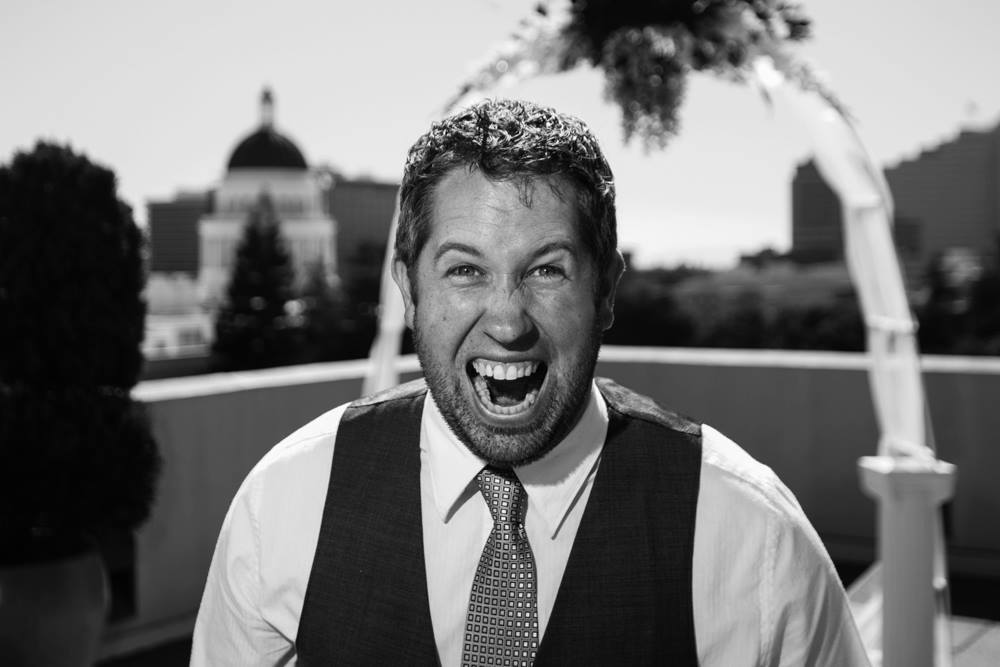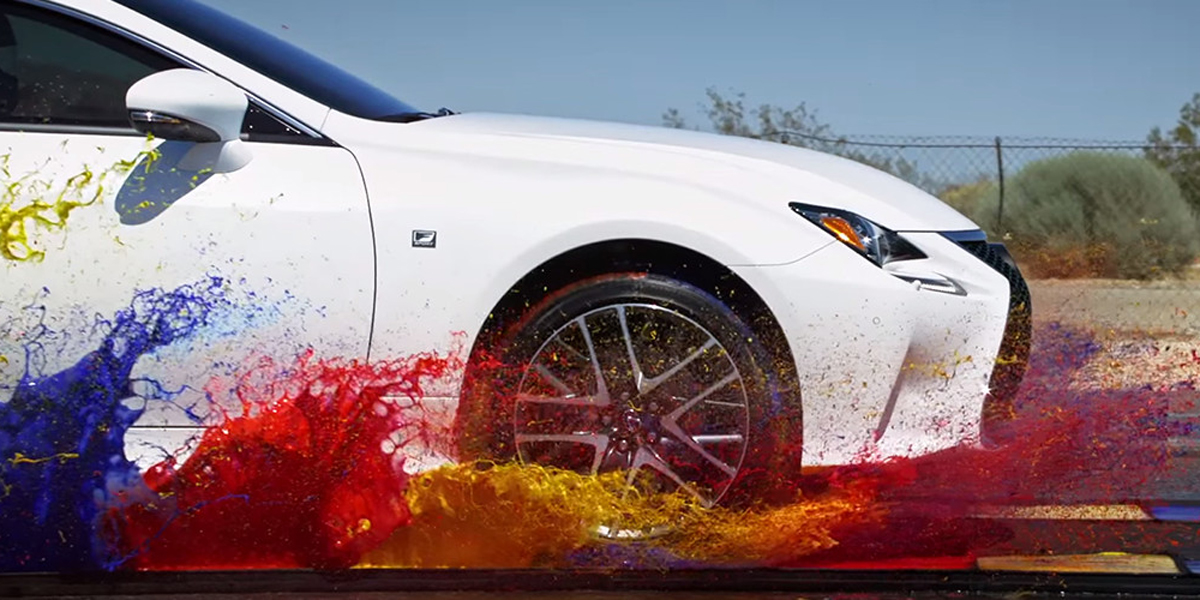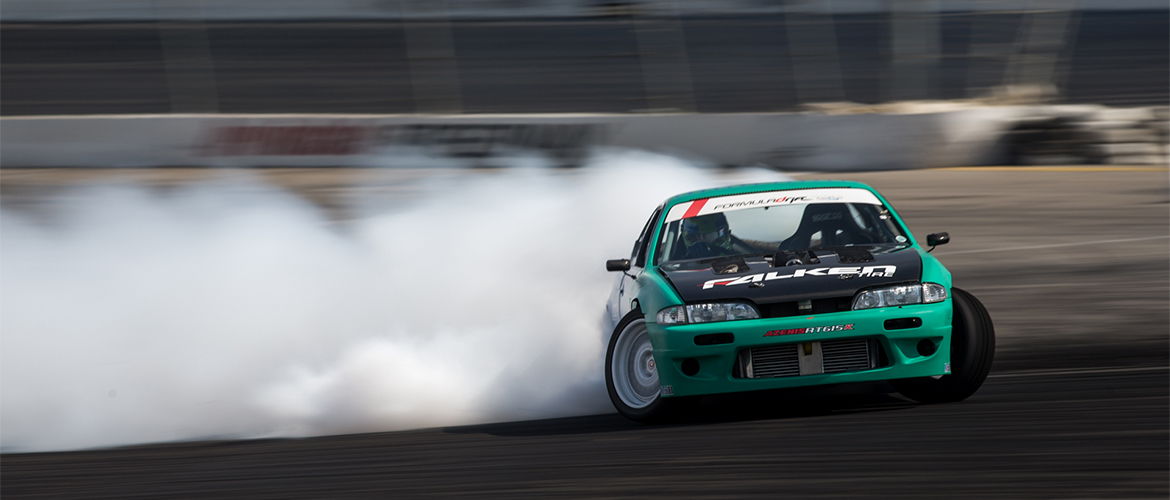The people we feature in this series certainly have the potential to inspire. They’ve done that for me, and I sincerely hope they inspire you in some way, as well. Since I decided to pick up the camera again, after a twenty year hiatus, I’ve gotten some of the best advice from these pros that I’ve EVER gotten. It’s all relevant and it all has inspired and helped me develop as a photographer. Larry Chen, for example, when he let me borrow his 400mm telephoto turned me away from the closer action to the open and expansive field behind me with far way cars on track, and said: “Don’t be afraid to look over here…anyone can fill a frame.” That single piece of advice changed the way I look at everything I shoot.
Andrew did something similar, just this year at Formula D Long Beach. We were discussing gear, and the cost of lenses in particular, when he told me, “You know where you want to be with your photography, so what are you waiting for? Spend it now and get the shots you want now.” That little nugget of truth pushed me towards getting the gear I felt like I needed to move to the next level. It was a “nut-up or shut-up” kind of moment, and he was exactly right. Had I not made the decision to get the gear, there are forty thousand shutter clicks this summer alone that I wouldn’t have gotten. Each one of those shots has made me a bit better…and I owe a lot of that to the people we speak to in this series.
Andrew Bohan’s sense of art and style is apparent in each photo he shares with us, either on his Facebook page, or on his website, Life Blasters. He has been producing a series he calls “365” which consists of a new photo from some part of his life, and he posts these for every day of the year. Each one is unique, and for each of the 300-odd days this year, I have not once been disappointed or disinterested. They are as simple as the environment around him, but the depths they deliver go way beyond a simple snapshot.
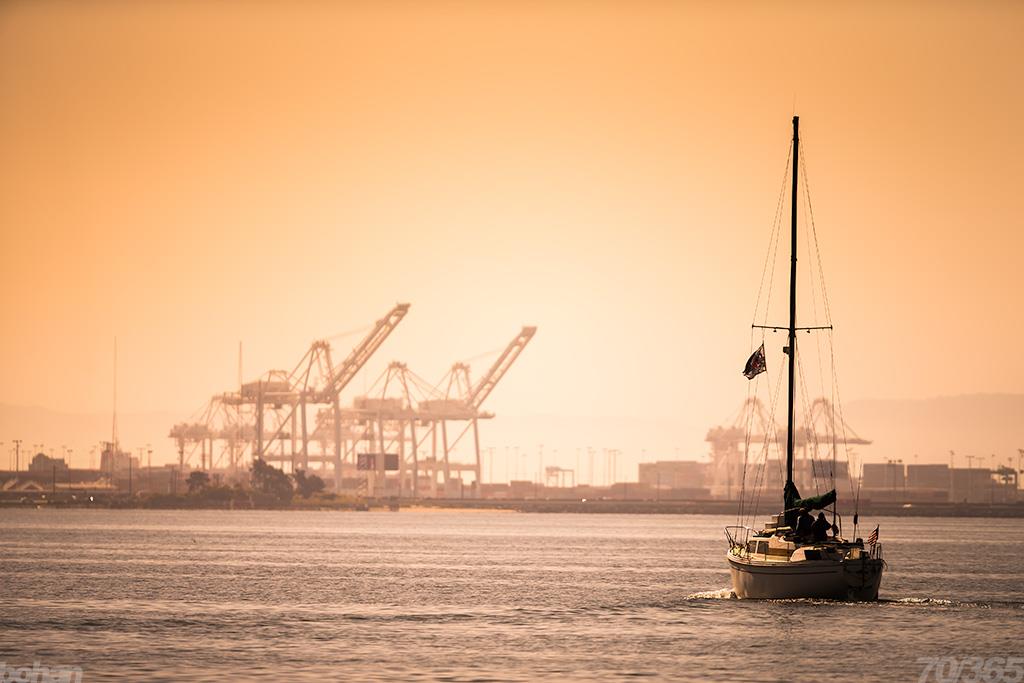
He is a unique cat, for sure, but an artist through and through. Besides the photography, Andrew is also an accomplished musician. Growing up playing trumpet, before teaching himself to play guitar at age 14, he played in a few bands during high school; and, eventually put together a subgroup where he was the singer and lead guitar, which toured with a stage band for a year. He was also in a band that played classics and oldies at fairs and car shows for a couple years.

ML@S: Tell me about your influences. Any one in particular who you look back to often, for inspiration or guidance?
Andrew Bohan: When I was a kid I loved looking at old paintings, like the works of DaVinci and Michelangelo, up through Van Gogh and Renoir. Those old paintings inadvertently gave me my first taste of composition, perspective, and how colors and light can be used. Impressionist paintings can also give you a good idea of what is important in a picture, since they’re pretty much devoid of any details. It’s all colors and shapes.
As for photography-specific influences, the first photographer I was a fan of was Charles Peterson. He made a name for himself shooting bands in Seattle in the 90’s, and he had this totally raw black-and-white style. If you come across any chaotic black and white Nirvana photos, they’re most likely his.
When I was in college I was minoring in Japanese and learned some calligraphy along with that. Visual balance is such an important part of Japanese/Chinese calligraphy and now that’s something I always consider in photography, too.
Lately though, I’ve just been absorbing everything I see.

ML@S: Where did you go to college?
AB: I did 3 years at Central Washington University. Started off majoring in Music but switched to Computer Science and minored in Japanese. I did an exchange program to Cal State Hayward (now Cal State East Bay), then transferred when my year was up and finished my BS in computer science, with a concentration in networking and data communications, and minored it math. I spent 4 years at CSUH, so seven years total. Not bad for switching schools and switching majors, I guess.

ML@S: Talk about your shooting style. Do you feel it’s unique to you? And how did it develop?
AB: The concept of “style” is a weird thing, isn’t it? I just shoot something in the best way I can find, and I don’t realize it’s my style until I see how someone else did it. When I encounter some situation I might subconsciously draw on two or three photos I’d seen somewhere before, if it’s a similar subject or setting or lighting condition. I often apply landscape principles to motorsports. If it works it works, so why not do that?
After shooting some other kinds of motorsports, I realized that Formula D has produced a group of photographers that are very different from the rest. Where I see a lot of tightly-cropped “car portraits” coming from other series, the Formula D School of Photography focuses more on the artistic side of it. It’s more important to make a beautiful photo than to simply show a car on the track. We tend to shoot a little wider, expose a little darker, shoot into the sun more often, maybe even pan so slow that most or all of the car isn’t sharp. That’s going back to impressionist painting. They didn’t need details, so maybe it’s not always necessary in photography either. If the viewer gets the impression of a car moving fast, then the shot is a success. That’s not to say it’s okay to be sloppy…there are still right and wrong ways to do it.
I do think we’re all unique within the group though. Some of us prefer wide lenses, some prefer telephoto. Some have distinctive editing styles, some keep it close to reality and others take more artistic liberties. I guess I like a lot of contrast. Kind of a gritty feel.
I’m sure I’ve been influenced a lot by that general Formula D style, or even helped propagate it. But who’s to say that I wouldn’t have found it on my own? Maybe I’m still around because it’s natural for me to shoot like that. Look at what happens when any of us bring that style to other events. Rally America, Pike’s Peak, American Le Mans, Gatebil, etc. It works everywhere and the established photographers in those series have been noticing. So in a sense, I’m definitely part of that group of guys who have gone that direction with motorsports photography, but I think you could probably still pick my shots out of a lineup.
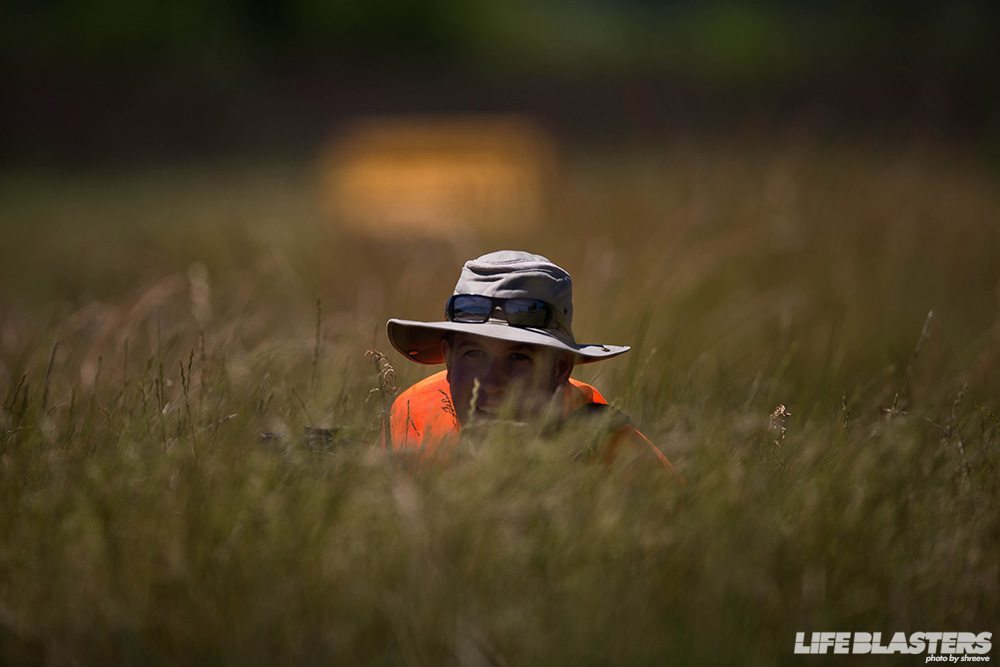
ML@S: Tell us a bit about how you got started.
AB: I was really into drawing as a kid. I’d draw spaceships and dinosaurs and other stuff all kids draw. My dad gave me his old Kodak Instamatic from the 60’s, but I never liked taking photos because I was limited to what was right in front of me. How could I take a photo of a dinosaur?
But then as I got into cars at the tail-end of high school, suddenly the thing I was interested in was photograph-able. I borrowed digital point-and-shoot cameras to try to take photos of my cars the way they did in the import magazines. Finding the angles was easy enough, but I realized I needed good locations and good lighting…and a better camera.
I got my own P&S [point-and-shoot] in 2002 and improved a lot. I shot my car of course, but then I got into shooting cityscapes, too. I shot my Taekwondo Team in college and daily life stuff around campus and in San Francisco. I even shot my first drift event with that camera, at Altamont Raceway in 2004. I was a driver but it was fun to shoot everyone else too. I read a lot about the technical aspects of photography and decided I’d never get anywhere with a P&S.
In 2005 I got my first DSLR. It wasn’t much but it allowed me to get the quality of photos needed to shoot models and get media credentials for events. I continued shooting at Altamont, and that’s where I developed my motorsports foundations. My friends always wanted me to come shoot them at track days so I started doing that in 2006. In 2007 I shot the San Jose Grand Prix and Formula D Sonoma, as well as a ton of smaller local events. Those events were the beginning of my modern portfolio.
After college I worked at a couple of tech jobs till the economy crashed, then I worked at Luke Lonberger’s old shop, SDP, till he shut it down; then I started my vinyl graphics shop, Lab17. Working with Luke and having my own business was what allowed me to start traveling around. Having to ask for time off from your job is no way to be a traveling photographer! While I was running Lab17 I just kept shooting events and other random stuff until I got good enough for people to want to hire me. Once that happened, you couldn’t believe how happy I was. I scaled back the vinyl business in 2011, just running it out of my garage, since I’m making most of my income from photography now.
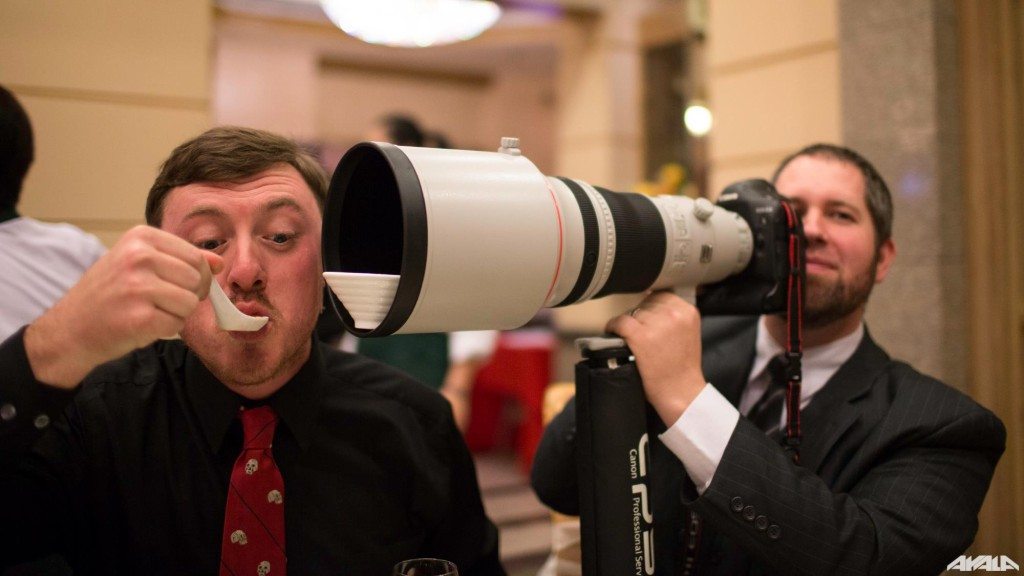
ML@S: Talk about your favorite event/series to cover. Why?
AB: It’s gotta be Formula D. I started out in drifting so it feels the most like home to me. It’s also where I have the most friends. I know half the drivers and all the staff guys, and of course the media guys are like family. There are a handful of media guys who’ve been doing it longer than I have, but I think I’m pretty much an OG now. Irwindale this year was my 30th round of FD.
ML@S: As a professional you’ve been able to travel extensively. Talk about some of your favorite places you’ve been for work.
AB: Well, I haven’t gotten to shoot out of the country yet, but I still get to have fun when I travel. Road Atlanta is my favorite track because of the scenery. Getting to hang out in New York is always fun so I can’t pass up events out that way. When I go to Seattle I always make a vacation out of it because that’s where I’m from, and my parents and other family and some old friends are still there. I bring my wife and daughter and stay for a few weeks. Shooting the Sno*Drift Rally in northern Michigan in January was completely miserable but totally worth it because of the unique visuals. Most people think of motorsports as a summertime thing, so seeing racing on icy roads flanked by a few feet of snow is awesome.
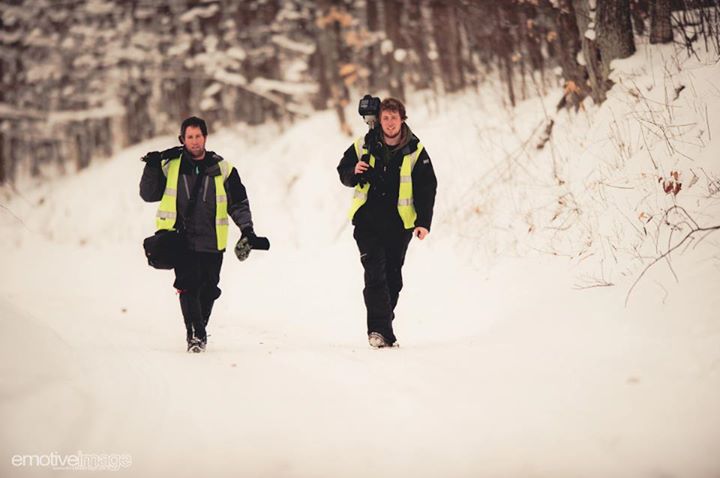
ML@S: What keeps you motivated?
AB: I want to be the best. And it’s my main source of income so I can’t get complacent. Motorsports photography is very competitive.
ML@S: Could you ever see yourself doing something else for a living?
AB: Sure, though I don’t know what. There was a time when being a professional photographer had never crossed my mind, so I don’t see why it couldn’t eventually be something else. I was a software QA engineer for a year so you never know.
ML@S: Has becoming a father changed the way you look at things when you shoot?
AB: I don’t think it has, or at least I haven’t noticed it. Maybe if someone analyzed my work in 100 years they’d find some noticeable turning point, but it’s certainly nothing I’ve done intentionally. It’s made it more important for me to be successful though. No doubt about that.
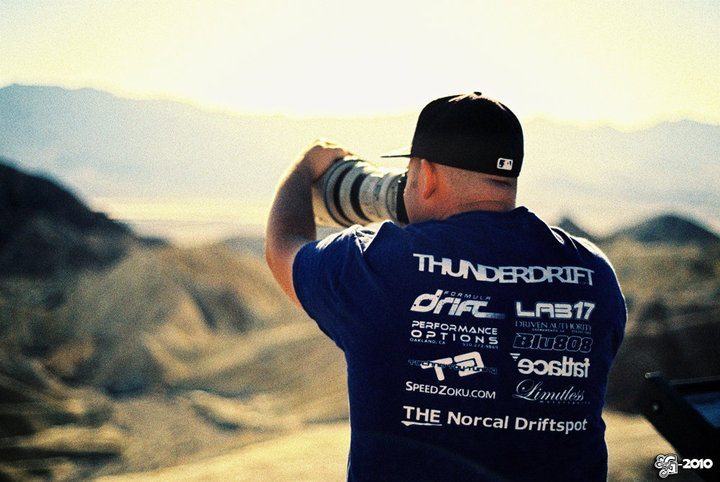
ML@S: You have a knack for seeing the extraordinary in everyday things and everyday scenes. Tell us how you decide that those moments should be photographed. One moment in particular comes to mind: a shot of the sun coming through the windows at the Seattle Airport and there are people moving through the frame. Tell me about the process of turning that seemingly ordinary scene into a work of art.
AB: I had just come up the escalator and got blinded by the sun. It was about an hour and a half before sunset so the sun was pretty low, but not yet on the horizon. It was reflecting off two airplanes and the floor as well as shining directly in, so it was just an incredible amount of light. I thought the silhouettes and long shadows of all the travelers conveyed how busy everything was, more so than if their faces and clothes were visible. I didn’t have to worry about if anyone was ugly or dressed wrong or anything like that. They’re just generic people.
So I got my camera and my widest lens out of my bag and moved around till the scene looked the best. I crouched down because I thought it would look better from down low, foreshortening the shadows. Then I took a few shots without looking through the viewfinder, in case there was anyone who was sensitive to being photographed in public, especially at an airport. I also didn’t want to look too suspicious to any TSA agents or airport staff wandering around. Satisfied with the settings, I waited for the right distribution of people. I didn’t want the scene to be so crowded that you couldn’t see the light and shadows, but also not so empty that it was boring. Thinking back to paintings, how would someone paint this scene? If I had complete control of the people, where would I put them? The frame I chose has three people close to the center and a few more on the edges and in the background. I also put the horizon line high in the frame, which isn’t common for interior shots I think. But most of the action was on the floor and the ceiling was basically just black, so that worked best.
Remember what I said about subconsciously drawing on photos I’d seen before? It turns out Peter Lee has a similar airport photo of silhouetted people with long shadows. That photo didn’t cross my mind at all while I was shooting, but I came across it just a few days ago and remembered that I’d seen it before. Though the basic idea is the same as mine, the execution is a lot different. Mine was shot with a wide lens, his lens was longer. Mine has people moving every direction, his has two people moving together. You get a different feeling from both, even though they are similar.

ML@S: Talk about Life Blasters. How did it come about and what does it mean?
AB: Back in 2010 I was running Lab17 and shooting and writing for OMG Drift, and my good buddy Geoff Pitts was running TD ProAm and shooting and writing for Works Mag. We decided to drive through Yosemite on the way from Northern California to Las Vegas, instead of the usual route south around the mountains. I decided it would be fun to document the trip, and while we were up there we were discussing how we didn’t have an outlet for that kind of material. My outlet was drift-only and his was a little more broad at general motorsports. But neither was anything close to what we needed for all the road trips we did and interesting stuff we encountered between events. Graffiti, live bands, weird restaurants, and anything to do with nature just had no place to go, so we decided to start a new blog site.
The site has grown a ton since we first launched it three years ago. When I left OMG Drift in 2011, Life Blasters became the outlet for all of my motorsports coverage. Now we’re a Formula D media partner, providing not just event coverage, but ancillary stories in between like the one we just put out about Danny George’s finances. Last year we started covering Rally America, shooting three rounds, and this year we’re covering the entire season. That’s coming a long way from just needing a place to post photos of Yosemite.
Of course the name of something has a lot to do with how it’s perceived. The name needed to be easy to spell when people heard it and it needed to be easy to say when people read it. That meant no weird words or cute ‘punny’ spellings. We liked the format “something somethings” like Speed Hunters or Motor Mavens. Then we had to think of what exactly it was that we were doing. Allen Saunders said, “Life is what happens to us while we are making other plans.” But we weren’t really operating that way. We weren’t letting life pass us by, we were blasting through it at full speed. Blasting through life. We were Life Blasters. It also happened to fit Del’s line in the Hiero song “At The Helm“: “Life is a blast when you know what you’re doin’.” And, well, you can’t really argue with that.
If you don’t know Andrew Bohan, you really need to take some time to get to know him, and the incredible work he’s doing over at Life Blasters. And be sure to check out all the amazing photos in his 365 series. Go get inspired…you’ll be glad you did.
andrewbohan.com
2013 365 project
lifeblasters.com
Life Blasters on FaceBook

